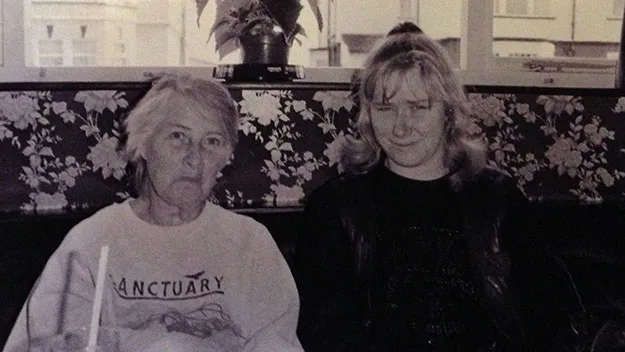Barb Cook was just 14 years old when her mother was dragged off to an asylum because she had autism. For the next 25 years, Barb tried keep her own symptoms hidden from medical professionals until she was finally diagnosed with Asperger’s at 40. Here, she writes about her journey from terror to acceptance and relief.
Watching my mother’s sleeping body strapped to a hospital bed, carried downstairs and put into an ambulance, was like watching a silent movie in slow motion. My mind tried to make sense of the situation. Why were they taking her away?
My father was convinced she was “mental” and had signed her into a psychiatric institution.
My mother had always been different. She was socially awkward, had no friends, and didn’t like to be touched or hugged.
Years later, comments my father made about her unfeminine ways would finally make sense to me.
Barb with her mother in the 1980s.

After three days we were allowed to visit. A 1980s UK psychiatric ward is not something any 14-year-old should experience. It was incredibly frightening and sad.
Mum was happy to see us. “I have done everything they asked of me, and I can come home now!” she exclaimed.
I’ll never forget her face when they refused. Her mistake was a huge meltdown. She was dragged away, drugged, and her true spirit was gone forever.
Over the next 15 years, she was permanently drugged as they tried to find a combination that worked. One such combination made her psychotic and she jumped from the roof. She became lost in her own world after 18 sessions of shock therapy.
Eventually, her life ended tragically when they gave her a toxic combination of medication.
She was finally gone from the tormented world of institutions, and I grew up with an enormous fear of mental health organisations and professionals, and that I could also have schizophrenia, manic depression and paranoia (as they misdiagnosed my mother).
Throughout my life, I struggled to fit in. Social situations overwhelmed me, and making eye contact was painful. I was labelled as stuck-up, but the reality was that I just had no idea how to carry a conversation.
I didn’t understand the world, and the fear of being locked away constantly made me fearful.
In the mid-1990s, I met Paul, who is now my partner. He understood me (and vice versa). Years later, an advertisement about Tourette’s made me wonder whether there was something different about us.
Modern technology meant that it was now much easier to search for such things, and I soon realised Paul had a form of autism, and a lot of the symptoms were ringing bells with me.
The word autism had previously brought to mind images of a non-verbal person flapping hands and rocking in the corner, shut off from the world.
I never realised that the Autism Spectrum could be so diverse. Days of researching the internet, reading books from the library, and even watching a movie calledMozart and the Whaleabout a couple with Asperger’s, was an emotional rollercoaster for both of us.
Paul collapsed in the middle of cooking dinner one night. His legs went weak from the sheer enormity of it all. In some ways it was like going through the five stages of grief: disbelief, grief, anger, despair and acceptance.
We both went to see a psychologist. Paul was quickly diagnosed with Asperger’s Syndrome, however I was initially misdiagnosed with Bipolar Disorder.
My fears were ignited; I was going to end up in an institution for the rest of my life. I left the office in despair. I didn’t know then that women and girls with autism or Asperger’s are often misdiagnosed with bipolar or a personality disorder.
As time went on Paul flourished, finally able to understand himself, but I felt doomed. I could not make the connection to my misdiagnosis of bipolar.
Six months later, we saw a new GP. She quickly confirmed I did not have bipolar. She watch the odd interactions between Paul and I (finishing each other’s sentences, and talking over the top of each other), and sent me to a psychiatrist.
I was videoed, filled out questionnaires, wrote an essay about my childhood, and completed reading and tracking tests which showed I had a learning difficulty despite having an IQ over 150. My final diagnosis was Asperger’s and ADHD.
At the time of testing, it was explained that my Asperger’s was “different”, however now a female profile of Asperger’s is emerging. A new diagnostic tool designed by Professor Tony Attwood will better improve the diagnostic process, sparing girls and women from damage caused by misdiagnosis.
Finally I also had acceptance in my life. We both now understand who we are, which gives us personal empowerment. We no longer listen to naysayers. More importantly, we now have a direction and a purpose to our different, but not less, lives.
Barb and Paul are embarking on a year-long motorcycle ride around Australia to film a new documentary, Autism All Grown Up, which will investigate the difficulties faced by adults on the spectrum.
For more information, visit the Australian Autism Asperger’s Network Inc website, Facebook page or email info@aaanetwork.com.au.
Donations to Barb and Paul’s documentary project can be made:
Via bank deposit to:
Bendigo Bank, Nambour, Queensland
Australian Autism Asperger’s Network Inc
BSB: 633000
Account number: 150253656
By money order or cheque to:
Australian Autism Asperger’s Network Inc.
PO Box 479, Pomona, Queensland, Australia, 4568
Or by Paypal using the email address:
donate@aaanetwork.com.au











